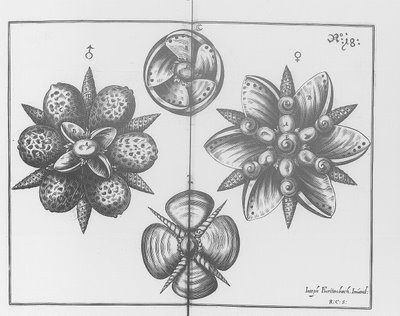
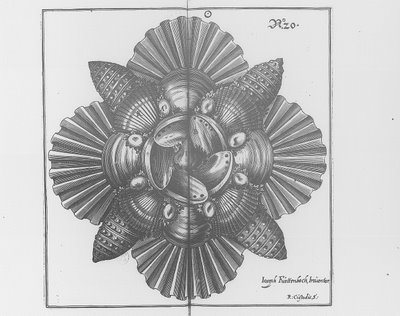
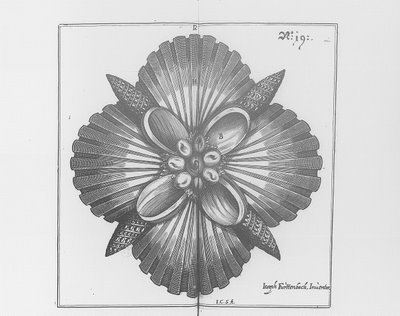
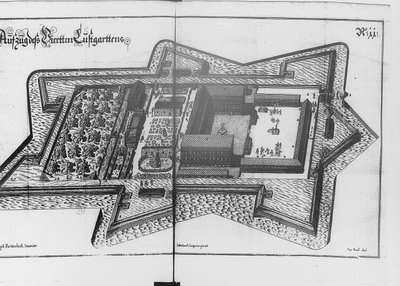
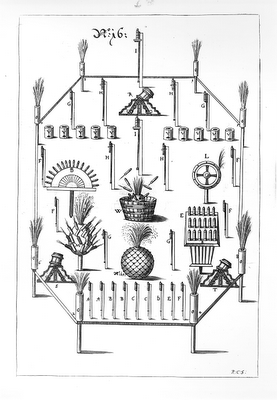

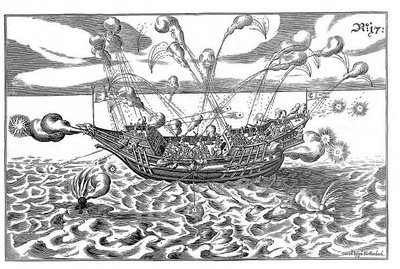





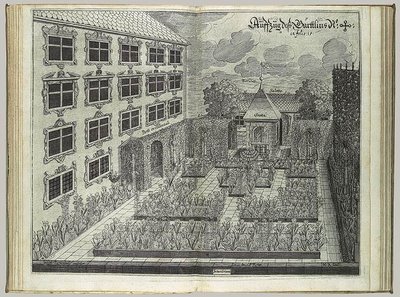
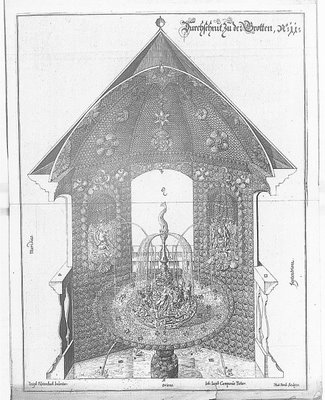


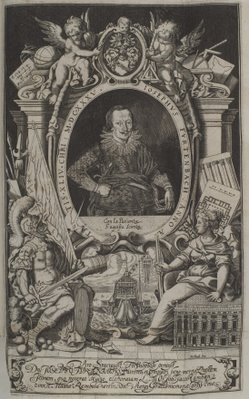
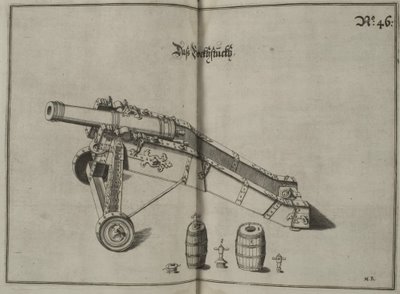


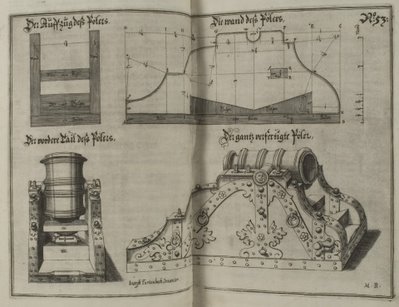
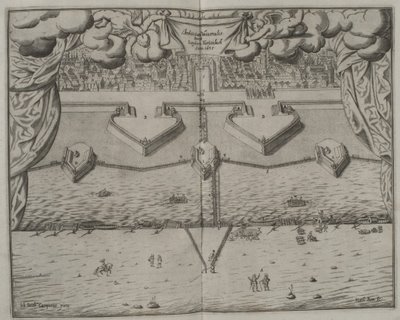
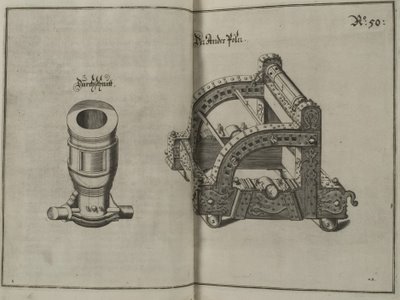
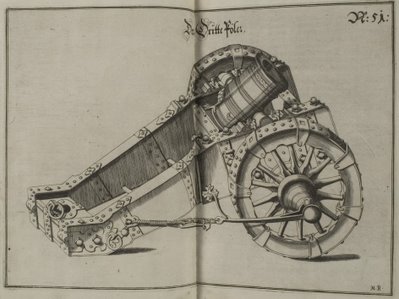
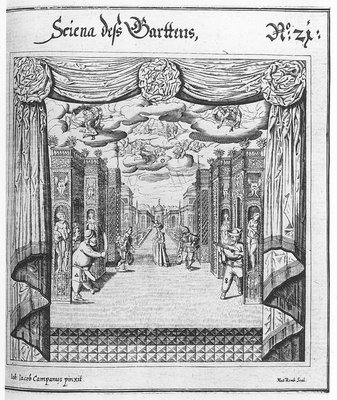
Although Joseph Furttenbach (1591-1667) spent the majority of his life in Ulm in southern Germany, it was a 10 year stay in Italy in his youth that informed his later professional output as an architect and author. He studied engineering, military architecture and stage design while in Tuscany and Florence and was influential in promoting design elements of the italian and french baroque schools in Germany.
Furrtenbach was something of a polymath and held various governmental positions in Ulm (including City Architect) where his interests included: cartography, chemistry (he described numerous gunpowder experiments he did himself in his pyrotechnics treatise), bridge, ship and organ building as well as elite home garden design.
"Furttenbach describes the grotto in his garden as being filled with artifice and exotica, including shell-encrusted sculptures and waterworks, painted cosmological imagery, and mirrors. His garden is a kind of open-air museum where the plants constitute the valued, living statues. The flowers are identifiable as the most sought after and costly bulbs of the period, the narcissus, tulip, fritillary, and crown imperial, demonstrating Furttenbach's knowledge of current botanical research."'Architectura Universalis' (the canon series of images above) remains his best remembered work - "[a] treatise on the engineering and building of fortifications, trenches, barracks, military schools, hospitals, lazarettos, bridges, moats, boats and boat-yards, guns, canons, and much more."
There have been various compilations of Furttenbach's works released and I'm reasonably confused as to which images (scattered across the internet) derive from which original book. To the best of my very limited understanding, his major works (all of which are represented above I believe) are:
--'Halintro-Pyrobolia'. 1627 (or: 'essays on guns, fireworks, sulfur, coal, and other substances used in the manufacture of explosives')
--'Architectura Civilis'. 1628
--'Architectura Martialis' 1629
--'Architectura Universalis'. 1635
--'Architectura Recreationis'. 1640 (stage and theatre design)
--'Architectura Privata' 1641
--'Mannhafter Kunst-Spiegel' 1663 (synthesis of previous architectural interests but combined with ideas about navigation, geography, astronomy and perspective)
- 'Architectura Universalis' at Heidelberg University (click on 'Titelblatt' then '-' at the bottom of the page for thumbnails: it's taken me a long time to work this trick out).
- 'Architectura Martialis' at BNF (engravings by Jacob Custodis)
- 'Architectura Civilis', 'Architectura Recreationis' at BNF (engravings by Raphaël Custodis)
- 'Architectura Privata' at BNF (engravings by Matthias Rembold)
- 'Architectura Civilis' at Heidelberg University (no illustrations)
- 'Halintro-Pyrobolia' (just 2 images) at Brown University. [UPDATE March 2014: the full volume in now available at U Heidelberg]
- Antiquarian Booksellers on 'Halintro-Pyrobolia'.
- Ursus Books on 'Architectura Universalis'.
- Krown & Spellman on 'Mannhaffter Kunst-Spiegel'.
- Hugh Pagan on 'Architectura Recreationis'.
- Related: The Stage Lighting Museum; The Development of Scenic Spectacle at Appalachian State University (renaissance/baroque theatres); Lighting of the Baroque Theatres by Jennifer MacGregor.
- Tangential: 'The Rise and Fall of Gardens in the Republic of Genoa, 1528 –1797' by Lauro Magnani [2.5Mb pdf extract from 'Bourgeois and Aristocratic Cultural Encounters in Garden Art, 1550-1850' Ed. Michael Conan 2002]
- This is not an exhaustive list (I've missplaced some links) but there isn't a great deal online about Furttenbach anyway [nb. there is a also 'Joseph Furttenbach' Junior, author]. And as an aside - Furttenbach is mentioned a number of times as an historic source in relation to the history of plague epidemics in the Ulm region: many of his family members apparently died.
- I've put my order in with Santa for a gold and silver, jewel-encrusted baroque mini-canon (full size version) for xmas.
- Update March 2009: The University of Halle have recently uploaded three works: Martialis, Navalis and Civilis in page scan format.



















5 comments :
what do the first three prints represent?
Yeah, sorry - I was tossing up whether to include the image titles as mouseovers or extra text but ended up leaving them as alt-tags because they are in french. (click img-properties)
Those 3 images are designs for shell ornaments (coquillage) for addition to garden walls or grottoes.
Isn't it amazing to think of the imaginations people had before the invention of television.....
charmed, i am just charmed by all the choices from the insects to here. thanks!
I open a page in french about "Architectura Navalis".
I link toward you.
Regards
Jm Urvoy
Paris - France.
Post a Comment
Comments are all moderated so don't waste your time spamming: they will never show up.
If you include ANY links that aren't pertinent to the blog post or discussion they will be deleted and a rash will break out in your underwear.
Also: please play the ball and not the person.
Note: only a member of this blog may post a comment.